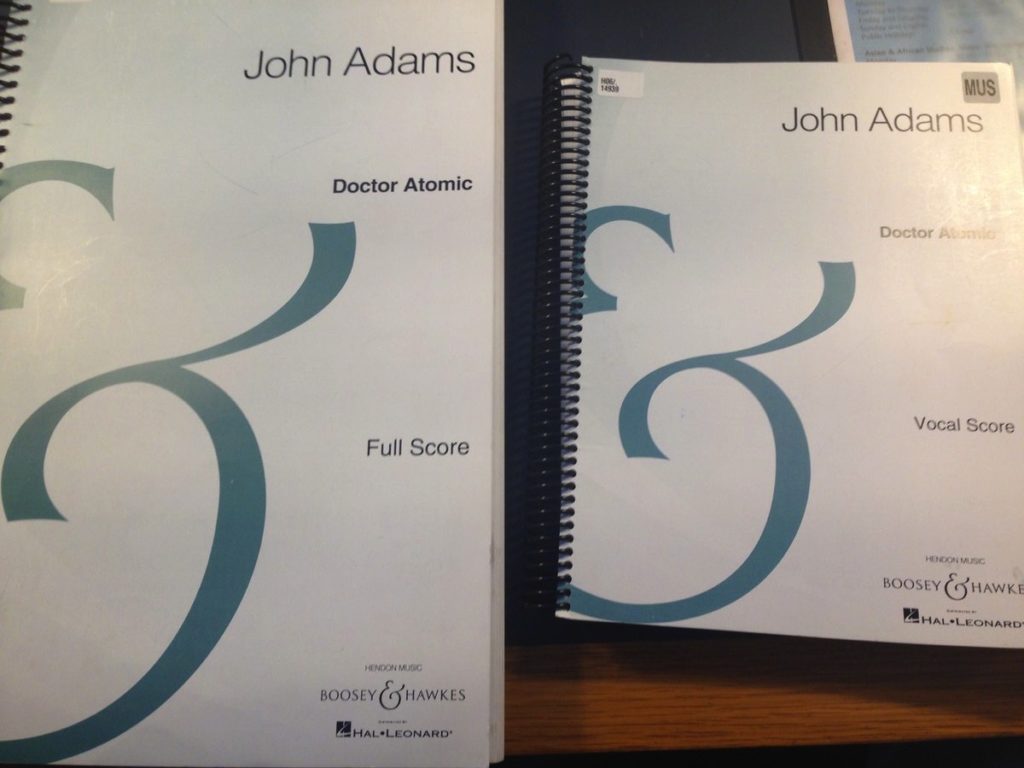Our Undergraduate Research Scholar Louisa Day joined the project team in Summer 2019. The UGRS Scholarship enabled Louisa to undertake research on the theme ‘Beyond Song’. We have collated more than 1700 song settings of Baudelaire’s poetry but what other types of musical adaptations can be found? In this second blog post, Louisa examines an opera and interrogates how a poem by Baudelaire fits within a modern opera about the atomic bomb.
John Adams’ 2005 opera Doctor Atomic carefully examines notions of responsibility and guilt in relation to the construction of the first atomic bomb. Compiled from original source material such as personal memoirs and recorded interviews, Peter Sellars’s libretto is therefore far from conventional. Most interestingly, it includes numerous references to Baudelaire’s Le Spleen De Paris prose poems : ‘Un Hémisphère dans une Chevelure’, ‘La Chambre Double’ and ‘Le Joueur Généreux’. In this blog post, I will pay particular attention to Act I Scene 2, considering Sellars’ use of Baudelaire and the scene’s relationship with the rest of the opera. Does it sit at odds with the work as a whole?
![]()
Music Scores of Doctor Atomic at the British Library ![]()
The opera focuses closely on the physicist Dr Oppenheimer (Oppie) and his relationship with his wife Kitty. Act I Scene 2 commences with Kitty’s recital of Muriel Rukeyser’s Three Sides of a Coin, using it as a medium to desperately call out for love and affection: ‘I love you/ and you should raise your head’. Oppie’s response cites Baudelaire’s ‘Un Hémisphère dans une Chevelure’, demonstrating his agreement and succumbing to the need for a romantic exchange. This is particularly apt as, according to John Adams, the real Oppie ‘and his wife had little coded signals to each other that were based on Baudelaire lines or some such text […]. So it’s appropriate, and no stretch of the imagination, that in this opera Oppenheimer would express his deepest thought in great poetry’.[1] The intimate nature of this scene is evident as the poem itself is very sensuous; the woman’s hair and perfume metaphorically transporting the narrator to exotic locations with ‘delightful climates’ and ‘a port resounding with/ melancholy songs’. As all the senses are evoked, revealing the all-encompassing nature of the narrator’s experience. Furthermore, the ‘hemisphere’ represents the narrator’s desire for escapism and to be transported away from this Earth, activated by the inhalation of the woman’s hair: ‘My soul floats upon perfumes’.
Considering this scene holistically, it seems in some ways to stunt the development and climatic suspense of the opera. It highlights its imperfect integration into Sellars’s libretto as the scene fails to admit its relevance to the preparation of the first atomic bomb, a colossal undertaking for the group of scientists. In the 2008 performance (directed by Lawrence Renes and Peter Sellars at the Het Musiektheater, Amsterdam) and the 2011 performance (conducted by Alan Gilbert at the Metropolitan Opera) of Doctor Atomic, the symbolic use of the bed adds to the small-scale intimacy between the couple. Perhaps this view of the scene’s stunting effect is overly harsh. In fact, Sellars’ zooming into their private, affectionate relationship acts as a reminder that life still continues despite the main action of the opera. In Act I Scene I, the singers’ presence looms large and this is accompanied by sophisticated use of staging and lighting. By contrast, Act I Scene 2 consists of a single illuminated bed (in both the 2008 and 2011 versions). Here, the varied staging shows that Sellars acknowledges the tendency to focus on the ‘grand story’, omitting the minor, less significant occurrences in the face of the grandiosity of the atomic bomb. Instead, he allows the beauty of the scene to be appreciated as equal to the rest of the opera as well as suggesting an explanation for its entitlement to be nuzzled in between the main action.
At this point in the opera, the music score reveals, time signature changes which are infrequent, remaining in simple time (either 2/4, 3/4, or 4/4) for almost the entirety of the scene (with rare instances of compound time 2/8, 3/2, 3/8 only constituting several bars each). By contrast, in Act I Scene 2, frequently varied time signatures create a more turbulent atmosphere. This more static and stable musical texture in scene 2 seems to signify a mode of reflection for the couple; it’s a time to realise that their love is the only constant in their lives.

These two opening scenes are emblematic of the opera’s illustration of the duality of Oppie’s life, the private versus the public, and this adds an additional layer to the opera. As for Baudelaire, whose poetry seems at first glance to be nestled rather incongruously within an opera about an atomic bomb, it is incredible to observe the resonances that his poetry still has today, and not just in the Francophone world. After all, his ability to access an Anglophone audience is testament to his mastery of French poetry.
[1]: John Adams, ‘John Adams on Doctor Atomic’, in The John Adams Reader: Essential Writings on an American Composer, ed. by Thomas May (Pompton Plain, NJ: Amadeus Press, 2006), pp.223-224.

























